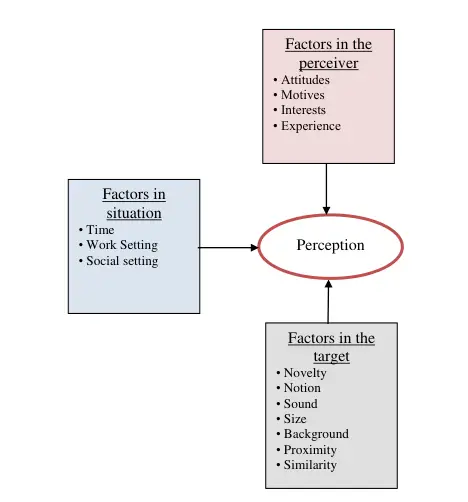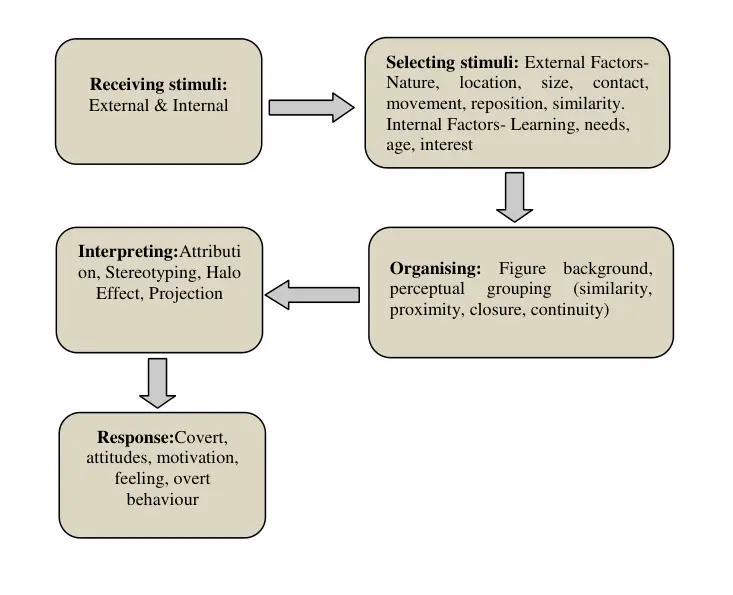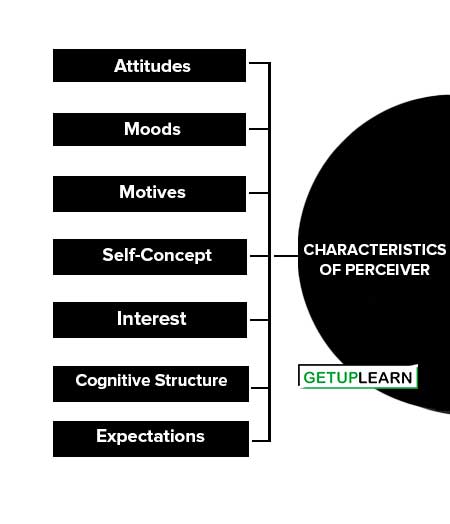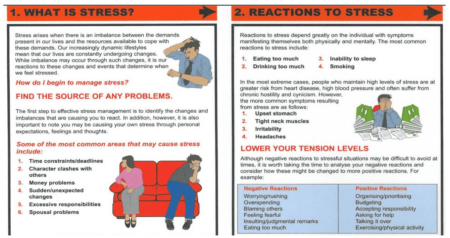Table of Contents
Perception in Organisational Behavior
We don’t see things as they are; we see things as we are.” Perception can be defined as a process by which individuals select, organize and interpret their sensory impressions, so as to give meaning to their environment.
Perception is a complex process and differs from person to person. People’s behavior is influenced by their perception of reality, rather than the actual reality.
Definition of Perception in Organisational Behavior
Perception is the process of receiving information and making sense of the world around us. It involves deciding which information to notice, how to categorize this information and how to interpret it within the framework of existing knowledge.
Getuplearn
Selection and organization of material which stems from the outside environment at one time or the other to provide the meaningful entity we experience.
Kolasa
Perception may be defined as a process by which individuals organize and interpret their sensory impressions in order to give meaning to their environment.
S.P. Robbins
Perception includes all those processes by which an individual receives information about his environment – seeing, hearing, feeling, tasting and smelling.
Joseph Reitz
Features of Perception
Following are some features of perception, which are as under:
- Perception is a mental process, whereby an individual selects data or information from the environment, organizes it, and draws significance or meaning from it.
- Perception is basically a cognitive or thinking process and an individual’s activities, emotions, feelings, etc. are based on his perception.
- Perception being an intellectual and cognitive process will be subjective in nature. This means that different people may perceive the same environment differently based on the effect of the environment.
Process of Perception
Perception involves five sub-processes. They are stimulus, registration, interpretation, feedback, and consequence. The following are the steps of the process of perception:
- Stimulus Situation
- Physiological Mechanism
- Interpretation is a Highly Crucial Sub-Process
- Feedback
- Perception Ends in Reaction or Respons

Stimulus Situation
Perception initiates with the presence of a stimulus situation. In organizational settings the superior forms the stimulus situation for the subordinate’s perceptual process.
Physiological Mechanism
Registration involves the physiological mechanism including both sensory and neural. Obviously, an individual’s physiological ability to hear and see influences his perception.
Interpretation is a Highly Crucial Sub-Process
Interpretation is a highly crucial sub-process. Other psychological processes assist in perceptual interpretation. For instance, in work settings, motivation, personality, and learning process determine an individual’s interpretation of a stimulus situation.
Feedback
Feedback is important for interpreting perceptual event data. In work settings, the psychological feedback that is likely to affect a subordinate’s perception may be in the form of a variation in the behavior of the superior.
Perception Ends in Reaction or Respons
Perception ends in reaction or response, which may be in the overt or covert form. As a consequence of perception, an individual responds to work demands. These sub-processes indicate the complexity of perception.
Factors Influencing Perception
A number of factors operate to shape and sometimes distort perception. These factors can reside in the perceiver, in the object or target being perceived, or in the context of the situation in which the perception is made.

Perceiver
When an individual looks at a target and attempts to interpret what he or she sees, the interpretation is heavily influenced by the personal characteristics of the individual perceiver. Among the more relevant personal characteristics affecting perception are attitudes, motives, interests, past experiences, and expectations.
Target
The characteristics of the target being observed can affect the perception. Loud people are more likely to be noticed than the quiet ones. There are extremely attractive and unattractive individuals. Motion, Sounds, Size, and other attributes of a target shape the way we see it.
Situation
The context in which we see the objects or events is important. Elements in the surrounding environment influence our perception. One may not notice a 25-year-old female in an evening gown and heavy makeup; yet the same woman, attired for management class would certainly catch attention.
Perceptual Process
Perception is the process that involves seeing, receiving, selecting, organizing, interpreting, and giving meaning to the environment. This meaning is built on past experiences and accumulated values. The process involves input-throughput-output.
There are various stimuli that act on a person which are cognitively processed by an individual and ultimately result in behavior or action. The steps of the perceptual process are explained below:

Stimuli
The process of perception starts with a stimuli. Through our sensory organs we receive various stimuli. Stimuli take five forms we see things, we hear sounds, we smell, we taste and we touch things.
Selection
Individuals are bombarded with enormous stimuli which are selectively accepted by them. They tend to pay attention to only these constituents of their environment which are consistent with or which reinforce their own expectations.
The selection is not random but depends on internal and external factors. Internal factors relate to a personal profile, age, sex, interest, etc. External factors that lead to selective selection are the intensity of stimuli, their size, color, movement, repetition, and so on.
Organization
Stimuli are organized to give some meaning to them. There are three ways by which the selected stimuli are organized. These ways are grouping closure, and simplification. Grouping is based on the similarity and proximity of various perceived stimuli.
Closure is used to fill the gaps in incomplete information to make them more meaningful. Simplification is used to make the information more meaningful and understandable. It can be said that this is the process of placing selected perceptual stimuli into a framework for “storage”.
Interpretation
The information collected and organized remains useless until some meaning is attached to it. Interpretation is the most important element of the entire perceptual process. The information collected and organized makes no sense without interpretation. Interpretation is basically assigning meaning.
Response
It is the last element in the perceptual process. It is the end result of the entire perceptual process. The action may be positive or negative. Action may also be overt or covert. An overt action is easily visible and covert action relates to a change in attitudes, opinions, feelings, impressions etc.
Characteristics of Perceiver
Several characteristics of the perceiver can affect perception. When an individual looks at a target and attempts to interpret what he or she stands: for, that interpretation is heavily influenced by the personal characteristics of the individual perceiver. The major characteristics of perceiver influencing perception are:

Attitudes
The perceiver’s attitudes affect perception. For example, suppose Mr. X is interviewing candidates for a very important position in his organization a position that requires negotiating contracts with suppliers, most of whom are male.
Mr. X may feel that women are not capable of holding their own in tough negotiations. This attitude will doubtless affect his perceptions of the female candidates he interviews.
Moods
Moods can have a strong influence on the way we perceive someone. We think differently when we are happy. In addition, we remember information that is consistent with our mood state better than information that is inconsistent with our mood state.
When in a positive mood, we form more positive impressions of others. When in a negative mood, we tend to evaluate others unfavorably.
Motives
Unsatisfied needs or motives stimulate individuals and may exert a strong influence on their perceptions. For example, in an organizational context, a boss who is insecure perceives a subordinate’s efforts to do an outstanding job as a threat to his or her own position.
Personal insecurity can be translated into the perception that others are out to “get my job”, regardless of the intention of the subordinates.
Self-Concept
Another factor that can affect social perception is the perceivers’ self-concept. An individual with a positive self-concept tends to notice positive attributes in another person. In contrast, a negative self- concept can lead a perceiver to pick out negative traits in another person. Greater understanding of self allows us to have more accurate perceptions of others.
Interest
The focus of our attention appears to be influenced by our interests. Because our individual interests differ considerably, what one person notices in a situation can differ from what others perceive.
For example, the supervisor who has just been reprimanded by his boss for coming late is more likely to notice his colleagues coming late tomorrow than he did last week. If you are preoccupied with a personal problem, you may find it hard to be attentive in class.
Cognitive Structure
Cognitive structure, an individual’s pattern of thinking, also affects perception. Some people have a tendency to perceive physical traits, such as height, weight, and appearance, more readily.
Others tend to focus more on central traits, or personality dispositions. Cognitive complexity allows a person to perceive multiple characteristics of another person rather than attending to just a few traits.
Expectations
Finally, expectations can distort your perceptions in that you will see what you expect to see.
FAQs Section
What is Perception?
Perception is the process of receiving information and making sense of the world around us. It involves deciding which information to notice, how to categorize this information and how to interpret it within the framework of existing knowledge.
What is the simple definition of perception?
Perception may be defined as a process by which individuals organize and interpret their sensory impressions in order to give meaning to their environment.
What are the 5 processes of perception?
The following are the steps of process of perception:
1. Stimulus Situation
2. Physiological Mechanism
3. Interpretation is a Highly Crucial Sub-Process
4. Feedback
5. Perception Ends in Reaction or Respons.
What are the factors influencing perception?
Perceiver, Target, and Situation are the three major factors influencing perception.
What are the 5 stages of the perceptual process?
Stimuli, Selection, Organization, Interpretation, and Response are the 5 stages of the perceptual process.
What are the characteristics of perceiver?
The characteristics of perceiver are: Attitudes, Moods, Motives, Self-Concept, Interest, Cognitive Structure, and Expectations.

